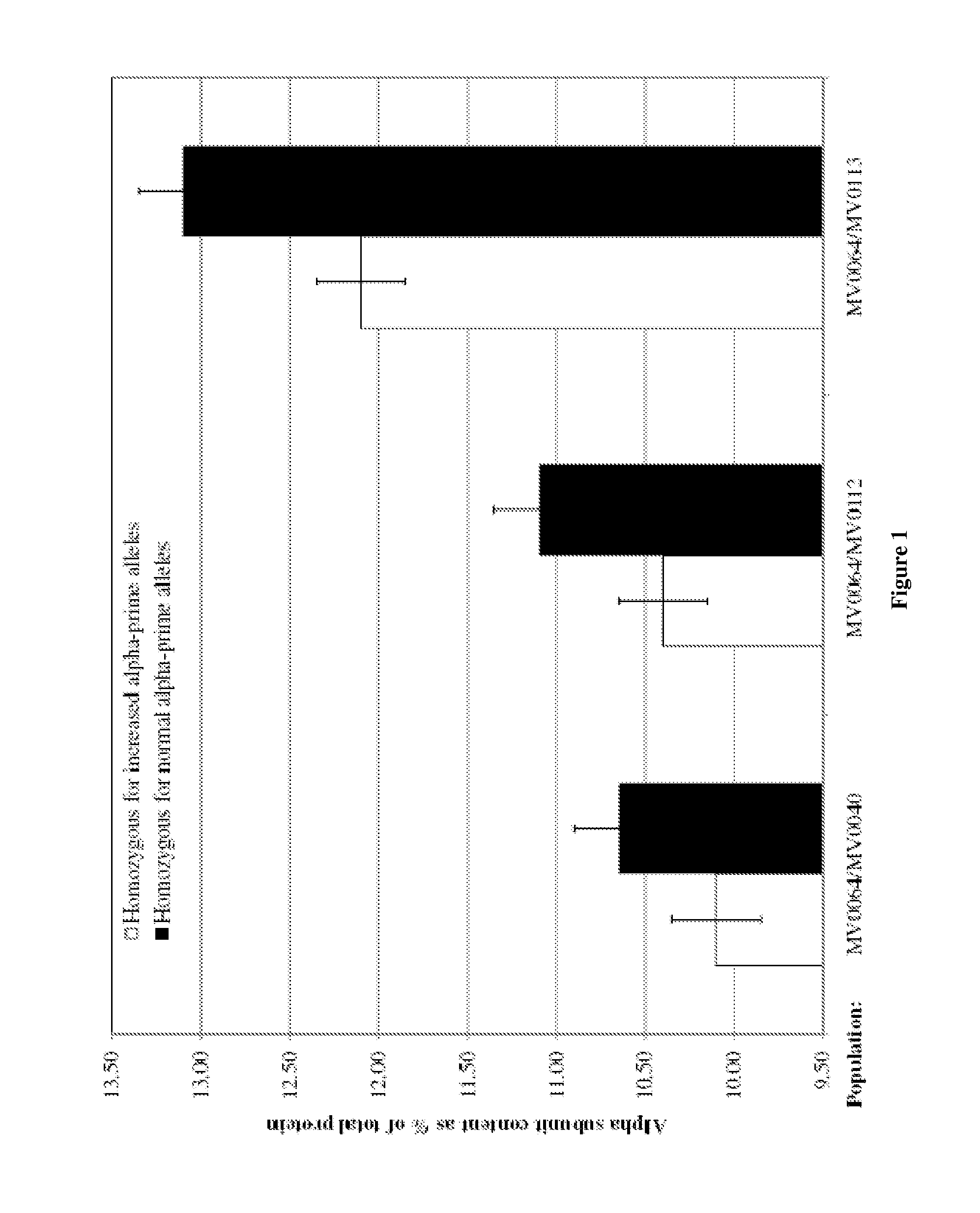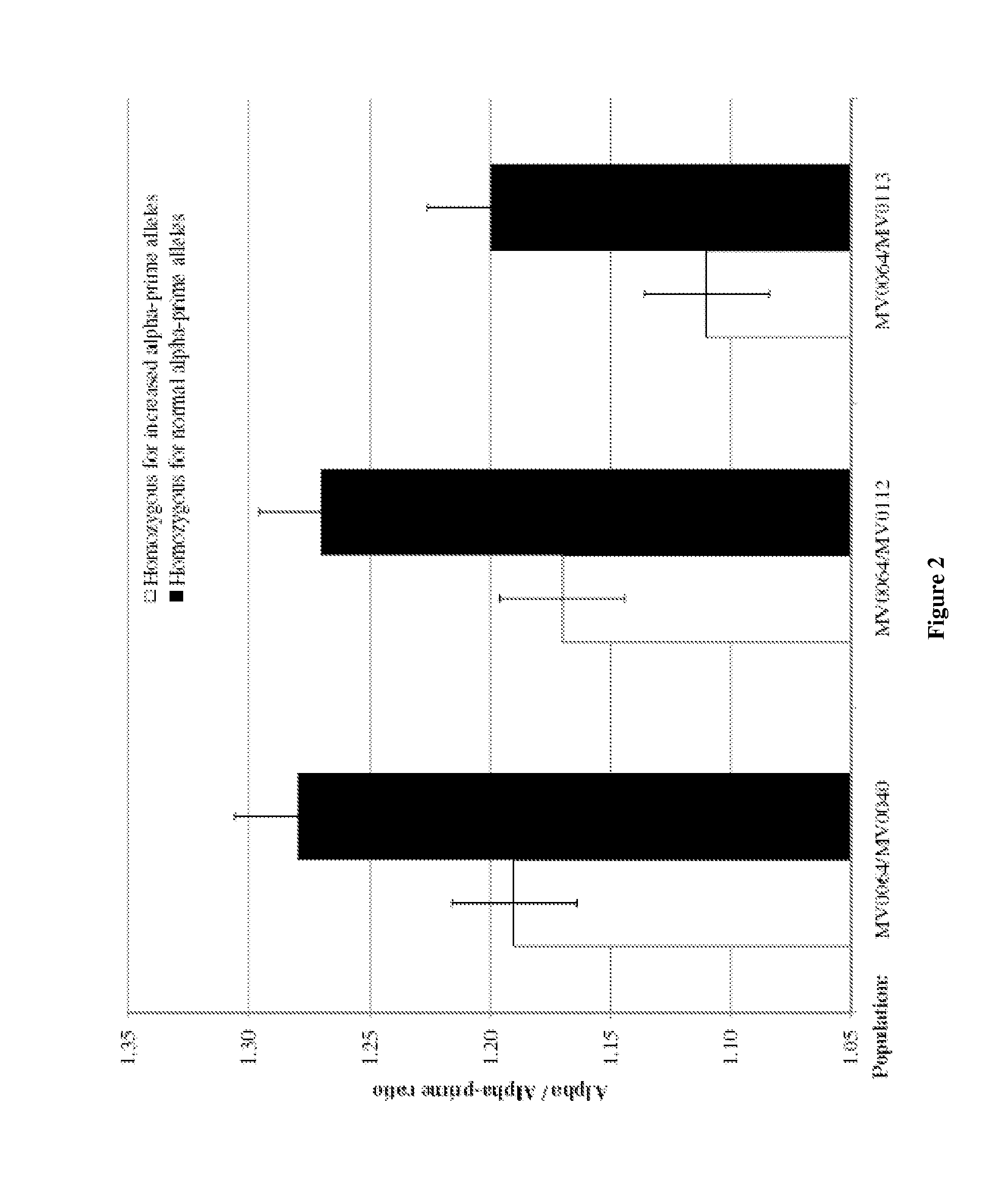Methods and Compositions for Increased Alpha-Prime Beta-Conglycinin Soybeans
a technology of betaconglycinin and soybeans, applied in the field of plant breeding and molecular biology, can solve the problems of difficult identification of individuals that are genetically superior, labor-intensive rflps typing stage, and general linkage that is difficult to discern, so as to improve yield, improve fatty acid composition, and improve the effect of oil production
- Summary
- Abstract
- Description
- Claims
- Application Information
AI Technical Summary
Benefits of technology
Problems solved by technology
Method used
Image
Examples
example 1
Genomic Region Associated with Increased α′-Subunit Phenotype
[0274]The relative percentages of α′, α, and β subunits in the β-conglycinin trimer are ˜35, 45, and 20%, respectively (Maruyama et al., 1999). The ratio of α:α′ is approximately 1.28 in most seeds. Select varieties were screened for increased α′-subunit content. Protein analysis was carried out as follows: soybean seeds from a single variety were pooled and ground using the CAT Mega-Grinder (SOP Asci-01-0002). Ground samples were stored at 4° C. For analysis, ˜30 mg of flour from each was weighed into one well of a 96 well 2 ml microtiter plate. Protein was extracted for 1 hour with shaking in 1.0 ml 1× Laemmli SDS buffer pH 6.8 containing 0.1M dithiothreitol (DTT) as a reductant. Following centrifugation, a portion of each extract was further diluted in SDS buffer to yield 0.2-0.5 μg / μL total protein, heated to 90-100° C. for 10 min, and cooled. For each sample, 1-2 μg total protein was loaded using a 12 channel pipet on...
example 2
[0277]Utility of Genetic Markers Associated with Increased α′-Subunit Across Different Genetic Backgrounds
[0278]Four populations were generated to verify alleles associated with increased α′-subunit content in seed of soybean. A decreased α-subunit line, MV0064 was crossed with two normal α-subunit line, MV0040 or MV0112, to create two populations. MV0064 has the decrease α-subunit content resulting increased α′-subunit content and shares the same common source of decreased α-subunit as MV0060 at the grandparent level. MV0040 or MV0112 share some common parents to MV0060, but have normal α-subunit content. The F2 populations are phenotyped for α′-subunit and α-subunit content and screened with SNP markers identified in Example 1. Moreover, a population was developed by crossing MV0064 with low glycinin parent, MV0113. MV0113 has reduced glycinin content (5% of total protein) and increased beta-conglycinin content (48% of total protein). The low glycinin parent has mutant Gy alleles ...
PUM
| Property | Measurement | Unit |
|---|---|---|
| temperature | aaaaa | aaaaa |
| temperature | aaaaa | aaaaa |
| temperature | aaaaa | aaaaa |
Abstract
Description
Claims
Application Information
 Login to View More
Login to View More - R&D
- Intellectual Property
- Life Sciences
- Materials
- Tech Scout
- Unparalleled Data Quality
- Higher Quality Content
- 60% Fewer Hallucinations
Browse by: Latest US Patents, China's latest patents, Technical Efficacy Thesaurus, Application Domain, Technology Topic, Popular Technical Reports.
© 2025 PatSnap. All rights reserved.Legal|Privacy policy|Modern Slavery Act Transparency Statement|Sitemap|About US| Contact US: help@patsnap.com



